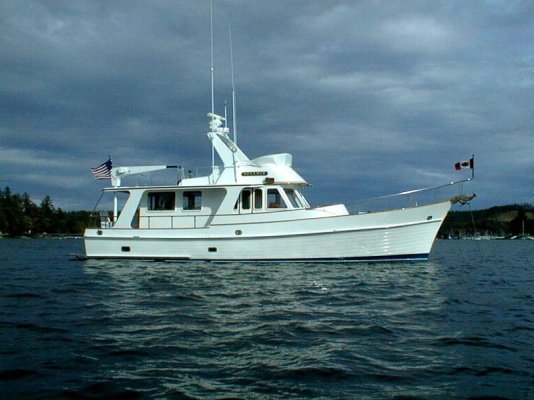timjet
Guru
- Joined
- Apr 9, 2009
- Messages
- 1,920
OK guys, we've thrown out a lot of "facts" that may or may not be true, myself included. I've talked to several boat owners who've confirmed that operating single engine on a planing hull boat saves money. This is real word experience, not theory.But why?
Lets review:
Fact: Planning hull boats have much bigger engines than displacement hull boats.
Fact: A certain amount of the power produced by any internal combustion engine is used to power the accessories and an additional amount of power is wasted in internal friction. Power that is not used to turn the prop and that otherwise does no good other than to enable the engine to run.
Fact: A properly configured planning hull boat will use approx 60 to 75% of it's available power to plane the boat at it's design cruising speed. Same for a displacement hull boat.
Fact: Fuel flow above 75% total power available on any internal combustion engine goes up dramatically.
Let's not get into a pissing contest over these percentages, they may be off, but not by much.
When I run at 8.3 knots, my engines (each) are producing 113 HP (of it's available 330 HP) at 1300 rpm. I'm running 2 engines with a total fuel flow of 4.9 g/hr and a total HP of 226 (2x113)
Shut one engine down and my speed is 7.1 knots, fuel flow 2.45 g/hr and total HP 113.
Why do I only loose 1.2 knots when I cut the HP by half?
Answer: Because at this low of speed and HP output, so much of the power output of the engine is wasted, ie used by accessories and lost by friction. So perhaps you could surmise that it takes 2 gal per hour just to turn the engine and yet produce no usable power. Eliminating that engine and you save 2 gal per hour.
Percentages again: At low rpm 75% of the power output of the engine is wasted, only 25% usable and I believe that is the answer.*
Lets review:
Fact: Planning hull boats have much bigger engines than displacement hull boats.
Fact: A certain amount of the power produced by any internal combustion engine is used to power the accessories and an additional amount of power is wasted in internal friction. Power that is not used to turn the prop and that otherwise does no good other than to enable the engine to run.
Fact: A properly configured planning hull boat will use approx 60 to 75% of it's available power to plane the boat at it's design cruising speed. Same for a displacement hull boat.
Fact: Fuel flow above 75% total power available on any internal combustion engine goes up dramatically.
Let's not get into a pissing contest over these percentages, they may be off, but not by much.
When I run at 8.3 knots, my engines (each) are producing 113 HP (of it's available 330 HP) at 1300 rpm. I'm running 2 engines with a total fuel flow of 4.9 g/hr and a total HP of 226 (2x113)
Shut one engine down and my speed is 7.1 knots, fuel flow 2.45 g/hr and total HP 113.
Why do I only loose 1.2 knots when I cut the HP by half?
Answer: Because at this low of speed and HP output, so much of the power output of the engine is wasted, ie used by accessories and lost by friction. So perhaps you could surmise that it takes 2 gal per hour just to turn the engine and yet produce no usable power. Eliminating that engine and you save 2 gal per hour.
Percentages again: At low rpm 75% of the power output of the engine is wasted, only 25% usable and I believe that is the answer.*

